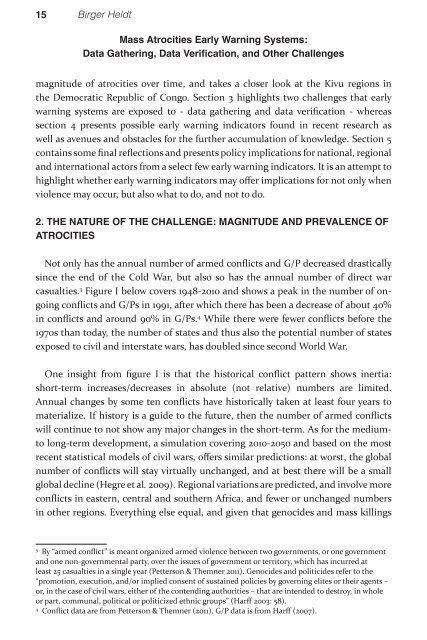GPANet-Report-2012
GPANet-Report-2012
GPANet-Report-2012
You also want an ePaper? Increase the reach of your titles
YUMPU automatically turns print PDFs into web optimized ePapers that Google loves.
15 Birger Heldt<br />
Mass Atrocities Early Warning Systems:<br />
Data Gathering, Data Verification, and Other Challenges<br />
magnitude of atrocities over time, and takes a closer look at the Kivu regions in<br />
the Democratic Republic of Congo. Section 3 highlights two challenges that early<br />
warning systems are exposed to - data gathering and data verification - whereas<br />
section 4 presents possible early warning indicators found in recent research as<br />
well as avenues and obstacles for the further accumulation of knowledge. Section 5<br />
contains some final reflections and presents policy implications for national, regional<br />
and international actors from a select few early warning indicators. It is an attempt to<br />
highlight whether early warning indicators may offer implications for not only when<br />
violence may occur, but also what to do, and not to do.<br />
2. THE NATURE OF THE CHALLENGE: MAGNITUDE AND PREVALENCE OF<br />
ATROCITIES<br />
Not only has the annual number of armed conflicts and G/P decreased drastically<br />
since the end of the Cold War, but also so has the annual number of direct war<br />
casualties. 3 Figure I below covers 1948-2010 and shows a peak in the number of ongoing<br />
conflicts and G/Ps in 1991, after which there has been a decrease of about 40%<br />
in conflicts and around 90% in G/Ps. 4 While there were fewer conflicts before the<br />
1970s than today, the number of states and thus also the potential number of states<br />
exposed to civil and interstate wars, has doubled since second World War.<br />
One insight from figure I is that the historical conflict pattern shows inertia:<br />
short-term increases/decreases in absolute (not relative) numbers are limited.<br />
Annual changes by some ten conflicts have historically taken at least four years to<br />
materialize. If history is a guide to the future, then the number of armed conflicts<br />
will continue to not show any major changes in the short-term. As for the medium-<br />
to long-term development, a simulation covering 2010-2050 and based on the most<br />
recent statistical models of civil wars, offers similar predictions: at worst, the global<br />
number of conflicts will stay virtually unchanged, and at best there will be a small<br />
global decline (Hegre et al. 2009). Regional variations are predicted, and involve more<br />
conflicts in eastern, central and southern Africa, and fewer or unchanged numbers<br />
in other regions. Everything else equal, and given that genocides and mass killings<br />
3 By “armed conflict” is meant organized armed violence between two governments, or one government<br />
and one non-governmental party, over the issues of government or territory, which has incurred at<br />
least 25 casualties in a single year (Petterson & Themner 2011). Genocides and politicides refer to the<br />
“promotion, execution, and/or implied consent of sustained policies by governing elites or their agents –<br />
or, in the case of civil wars, either of the contending authorities – that are intended to destroy, in whole<br />
or part, communal, political or politicized ethnic groups” (Harff 2003: 58).<br />
4 Conflict data are from Petterson & Themner (2011), G/P data is from Harff (2007).


